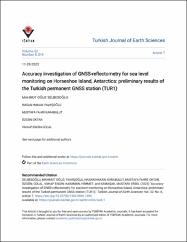| dc.contributor.author | Selbesoğlu, Mahmut Oğuz | |
| dc.contributor.author | Yavaşoğlu, H. Hakan | |
| dc.contributor.author | Karabulut, M. Fahri | |
| dc.contributor.author | Oktar, Özgün | |
| dc.contributor.author | Gülal, V. Engin | |
| dc.contributor.author | Karaman, Himmet | |
| dc.contributor.author | Kamaşak, M. Ersel | |
| dc.date.accessioned | 2024-04-16T14:12:48Z | |
| dc.date.available | 2024-04-16T14:12:48Z | |
| dc.date.issued | 2023 | en_US |
| dc.identifier.citation | Selbesoğlu, M. O., Yavaşoğlu, H. H., Karabulut, M. F., Oktur, Ö., Gülal, V. E., Karaman, H., & Kamaşak, M. E. (2023). Accuracy investigation of GNSS-reflectometry for sea level monitoring on Horseshoe Island, Antarctica: Preliminary results of the Turkish permanent GNSS station (TUR1). TURKISH JOURNAL OF EARTH SCIENCES, 32(8), 1013-1021. https://doi.org/10.55730/1300-0985.1890 | en_US |
| dc.identifier.issn | 1300-0985 | |
| dc.identifier.uri | https://hdl.handle.net/20.500.12900/345 | |
| dc.description.abstract | Antarctica is called a natural laboratory and is highly important for investigating climate change and its evolution over time. Sustainability is a critical concern due to the challenges posed by glacier melting and rising sea levels due to global warming. According to the Intergovernmental Panel on Climate Change, since the industrial age, the global mean sea level has risen by about 20 cm as a result of the increase in the average world temperature by 1 degrees C. Therefore, long-term observations by satellite-based techniques in and around Antarctica are of great importance for monitoring the impacts of climate change. In the last two decades, the Earth has been monitored by satellite-based remote sensing systems with high temporal and spatial resolution. Nowadays, Global Navigation Satellite System (GNSS) signals are increasingly being used in climate change studies. In this context, Turkiye's first GNSS stations were successfully installed during the fourth Turkish Antarctic Expedition (TAE-IV) on Horseshoe Island, Antarctica, within the scope of a project by the Scientific and Technological Research Council of Turkey (TuBITAK) titled "Monitoring the troposphere and snow depth/thickness in the Antarctic region with GNSS meteorology and GNSS-reflectometer methods". These stations have been monitoring atmospheric water vapor and changes in snow/sea levels since February 24th, 2020. In this study, one of the permanent GNSS Station (TUR1) signals was analyzed using GNSS-reflectometry (GNSS-R) in order to monitor the sea level changes on Horseshoe Island. Sea level changes of around 1 m in this region, due to the tidal effect, were observed using GNSS-R and compared with ultrasonic distance measurement sensor results for validation. The first results for monitoring sea levels obtained from the TUR1 GNSS Station demonstrated that sea levels in the region can be monitored using GNSS-R with an accuracy of 3-4 cm and correlation of 0.91. | en_US |
| dc.language.iso | eng | en_US |
| dc.publisher | Scientific and Technological Research Council Turkey | en_US |
| dc.relation.isversionof | 10.55730/1300-0985.1890 | en_US |
| dc.rights | info:eu-repo/semantics/openAccess | en_US |
| dc.subject | Antarktika | en_US |
| dc.subject | Antarctica | en_US |
| dc.subject | Deniz seviyesi değişimi | en_US |
| dc.subject | Sea level change | en_US |
| dc.subject | İklim değişikliği | en_US |
| dc.subject | Climate change | en_US |
| dc.title | Accuracy investigation of GNSS-reflectometry for sea level monitoring on Horseshoe Island, Antarctica: preliminary results of the Turkish permanent GNSS station (TUR1) | en_US |
| dc.type | article | en_US |
| dc.department | İstanbul Atlas Üniversitesi, Mühendislik ve Doğa Bilimleri Fakültesi, Bilgisayar Mühendisliği Bölümü | en_US |
| dc.authorid | https://orcid.org/0000-0002-5397-3303 | en_US |
| dc.contributor.institutionauthor | Gülal, V. Engin | |
| dc.identifier.volume | 32 | en_US |
| dc.identifier.issue | 8 | en_US |
| dc.identifier.startpage | 1013 | en_US |
| dc.identifier.endpage | 1021 | en_US |
| dc.relation.journal | TURKISH JOURNAL OF EARTH SCIENCES | en_US |
| dc.relation.publicationcategory | Makale - Uluslararası Hakemli Dergi - Kurum Öğretim Elemanı | en_US |

















